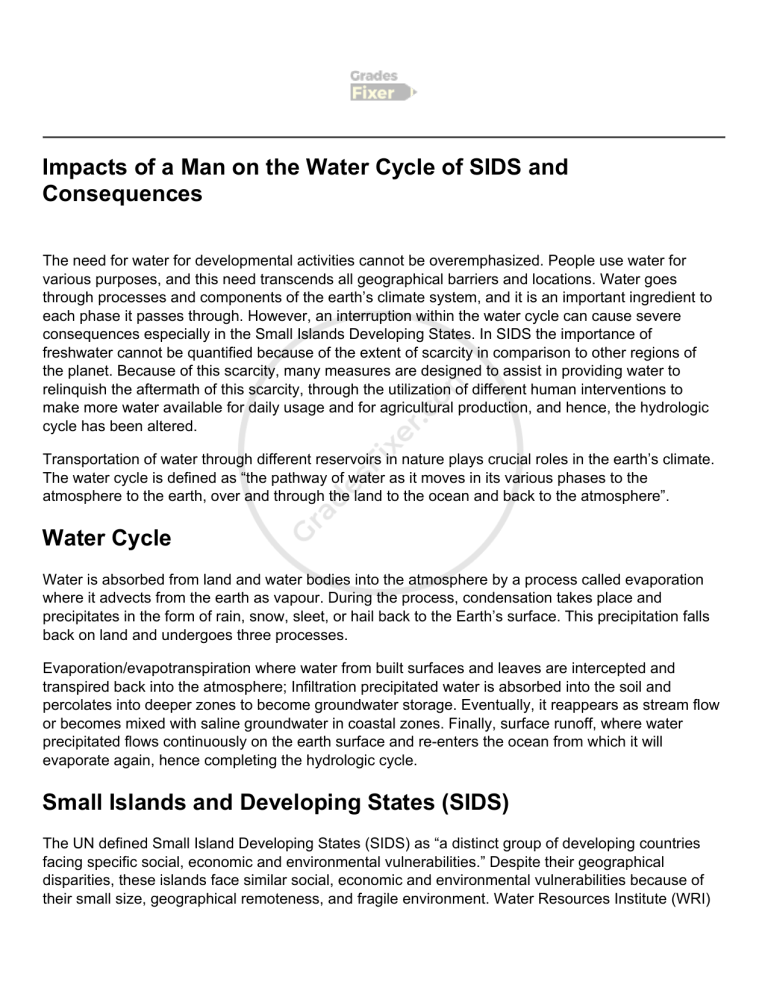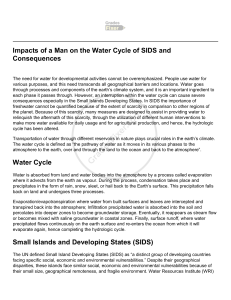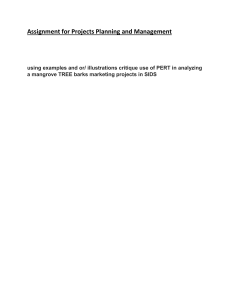
Impacts of a Man on the Water Cycle of SIDS and Consequences The need for water for developmental activities cannot be overemphasized. People use water for various purposes, and this need transcends all geographical barriers and locations. Water goes through processes and components of the earth’s climate system, and it is an important ingredient to each phase it passes through. However, an interruption within the water cycle can cause severe consequences especially in the Small Islands Developing States. In SIDS the importance of freshwater cannot be quantified because of the extent of scarcity in comparison to other regions of the planet. Because of this scarcity, many measures are designed to assist in providing water to relinquish the aftermath of this scarcity, through the utilization of different human interventions to make more water available for daily usage and for agricultural production, and hence, the hydrologic cycle has been altered. Transportation of water through different reservoirs in nature plays crucial roles in the earth’s climate. The water cycle is defined as “the pathway of water as it moves in its various phases to the atmosphere to the earth, over and through the land to the ocean and back to the atmosphere”. Water Cycle Water is absorbed from land and water bodies into the atmosphere by a process called evaporation where it advects from the earth as vapour. During the process, condensation takes place and precipitates in the form of rain, snow, sleet, or hail back to the Earth’s surface. This precipitation falls back on land and undergoes three processes. Evaporation/evapotranspiration where water from built surfaces and leaves are intercepted and transpired back into the atmosphere; Infiltration precipitated water is absorbed into the soil and percolates into deeper zones to become groundwater storage. Eventually, it reappears as stream flow or becomes mixed with saline groundwater in coastal zones. Finally, surface runoff, where water precipitated flows continuously on the earth surface and re-enters the ocean from which it will evaporate again, hence completing the hydrologic cycle. Small Islands and Developing States (SIDS) The UN defined Small Island Developing States (SIDS) as “a distinct group of developing countries facing specific social, economic and environmental vulnerabilities.” Despite their geographical disparities, these islands face similar social, economic and environmental vulnerabilities because of their small size, geographical remoteness, and fragile environment. Water Resources Institute (WRI) and the Massachusetts Institute of Technology (MIT) predicts that the water scarcity will continue to increase in the future, with around 52% of the world’s population living in water-stressed regions by 2050. Impacts of a Man on the Water Cycle of SIDS and Consequences The quest for a comfortable life by man since time has had its diverse consequences on the environment. The cycles and processes in nature are influenced directly or indirectly by human activities. Human activities that have impacted negatively on the water cycle especially in the SIDS include; Changes in land use and land cover have affected water resources. According to Yu L et al, land use/land cover changes affect the water cycle through vegetation interception, runoff, surface infiltration, and soil moisture status, thereby affecting the process of watershed hydrology and water resource cycles. Groundwater mining is another activity because due to shortages of surface water for carrying out productive purposes in SIDS, the groundwater becomes the only reliable source of water and this has been the case in south-eastern Spain and the Canary Islands. The aquifer is made up of 'fossil water' from wetter climates and as a consequence, aquifers are often intensively exploited and some of them are subjected to continuous depletion of their reserves. Reclamation of wetlands of SIDS especially in Seychelles can result in changes in regional water balance, as it influences the evapotranspiration and run-off of wetlands. It lowers the water table and may induce soil moisture stress, reduce transpiration, and increase dry season flows. Agriculture and Irrigation Schemes affects the hydrologic cycle negatively. When groundwater is harnessed for agriculture over time, it could disrupt the water cycle by increasing the rates of evapotranspiration. This is because the water used for irrigation evaporates rather than becoming a surface run-off or infiltrating into the groundwater reserve and hence, influences the atmosphere. Deforestation which is the removal of trees without replacement has negative impacts on the hydrologic cycle. Different factors contribute to promote deforestation including wildfires, clear-cutting, or conversion into other land uses, and these areas lose their abilities to influence the hydrologic cycle. When the abundance and complexities of forests is changed, it disrupts their abilities to sustain transpiration, and increases stream flow volumes. Hydroelectric power projects require the establishment of dams and reservoirs. These are consequent in altering stream flows, increasing water temperature, turbidity (amount of sediment in the water) and oxygen content. This alteration of the natural water cycle can then affect native fish, for example, salmon and other aquatic biotas which rely on spring floods to create wetlands habitat needed for sustaining their availability. Conclusion Water is of great relevance to the functioning of processes on the Earth. Water goes through a continuous cycle as it moves from one component to the other. The activities of man in Small Islands Developing States on the water cycle has detrimental consequences that might occur on either the local or global level and at each level, the impact felt is hazardous. However, if proper management and environmental sustainability measures are adhered to, some of these consequences can be mitigated both at all levels. Need Help With The Assignment? Our professionals are ready to assist with any writing! GET HELP


